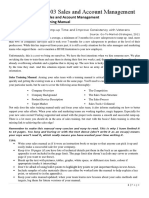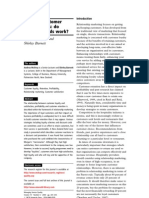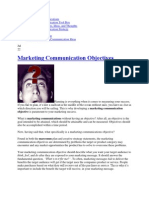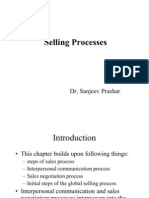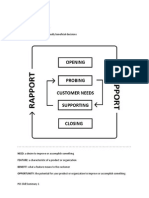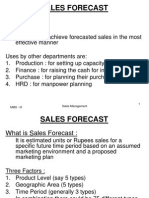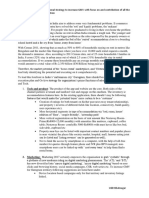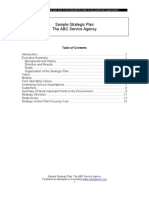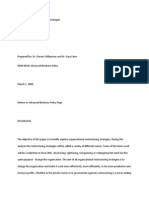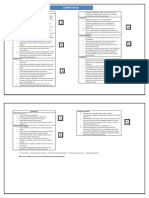Professional Documents
Culture Documents
Sales Performance in b2b
Sales Performance in b2b
Uploaded by
Udit Bhatnagar0 ratings0% found this document useful (0 votes)
104 views14 pagestells about the industrial or b2b sales attributes, the process and the manner to enhance.
Original Title
sales performance in b2b
Copyright
© © All Rights Reserved
Available Formats
PDF, TXT or read online from Scribd
Share this document
Did you find this document useful?
Is this content inappropriate?
Report this Documenttells about the industrial or b2b sales attributes, the process and the manner to enhance.
Copyright:
© All Rights Reserved
Available Formats
Download as PDF, TXT or read online from Scribd
Download as pdf or txt
0 ratings0% found this document useful (0 votes)
104 views14 pagesSales Performance in b2b
Sales Performance in b2b
Uploaded by
Udit Bhatnagartells about the industrial or b2b sales attributes, the process and the manner to enhance.
Copyright:
© All Rights Reserved
Available Formats
Download as PDF, TXT or read online from Scribd
Download as pdf or txt
You are on page 1of 14
A re-examination of B2B sales performance
Ronald Zallocco, Ellen Bolman Pullins and Michael L. Mallin
College of Business Administration, University of Toledo, Toledo, Ohio, USA
Abstract
Purpose The purpose of this paper is to contribute to the understanding of sales performance measurement by developing an organizing framework
for classifying sales performance measures based on the various performance criteria used by researchers. Subsequently, the results of both a focus
group and in-depth interviews with sales managers and salespeople will be presented using the classication framework developed. The objective is to
determine whether gaps exist between how researchers and practitioners view and classify salesperson performance measures as well as to provide
insights to effective sales management practices in areas such as salesperson skill development, goal attainment, resource allocation, and customer
relationship management.
Design/methodology/approach A qualitative study, using in-depth interviews, explores the relationship between sales managers and salespersons
and their respective views on sales performance measurement. The interview questions were developed using information derived from a sales
executive focus group. In-person in-depth interviews were conducted with eight sales managers and eight salespeople from eight organizations.
Findings The paper proposes a new method for organizing the types of performance measures that are used, crossing effectiveness-efciency with
internally-externally-focused measures. The ndings indicate that a gap appears to remain between the attributes of performance that researchers
focus on and what occurs in the world of sales.
Research limitations/implications The ndings suggest that sales control theories can be used to present an organizing framework of sales
performance based on sales outputs, salesperson skill/capability development, sales activities, and market indicators. Our typology might serve as a
way to better understand certain research areas where there have been inconsistent ndings, and should lead to new measure development for
empirical research. In addition, a number of manager and salesperson recommendations for the practicing sales manager are reviewed.
Originality/value This paper helps to clarify an area that is characterized by ambiguity and an identied need to identify new performance metrics.
Keywords Qualitative research, Business-to-business marketing, Sales management, Sales force
Paper type Research paper
An executive summary for managers and executive
readers can be found at the end of this article.
One of the most important issues in personal selling and
sales management is the measurement of sales performance.
The most obvious measure is a resultant sale. However, with
growing recognition of the importance that customer loyalty,
customer satisfaction, long-term relationship management,
and customer knowledge management play in the strategic
success of an organization, rms look beyond the
transaction-based concepts of unit sales and immediate
revenue when measuring and evaluating sales performance.
Most recently, sales researchers have indicated a need to
reevaluate sales performance metrics (e.g. Haines, 2004;
Ingram et al., 2005; Mazur, 2002). For example, in their
review of new directions for sales leadership research, Ingram
et al. (2005, p. 148), identify the following research question:
How do you measure sales success at the salesperson
performance level?. Sales organizations are being asked to
do more things, and the job has become more complex.
Certainly accountability follows naturally as a performance
challenge for the sales force (Brown and Jones, 2005). Given
this emphasis on accountability, appropriate sales metrics
must be identied and utilized. However, questions still loom
as to which metrics are appropriate under what
circumstances, and how they can best be developed
(Ingram et al., 2005).
This paper will contribute to the understanding of sales
performance measurement in three ways:
1 to identify the performance criteria used by researchers, a
review of extant research on sales performance and sales
control frameworks will be presented;
2 an organizing framework for classifying sales performance
measures will be developed; and
3 the results of both a focus group and depth interviews
with sales managers and salespeople will be presented,
providing an opportunity to map their thoughts on sales
performance measurement with the classication
framework developed for this research.
The objective is to determine whether gaps exist between how
researchers and practitioners view and classify salesperson
performance measures. Beyond salesperson performance
measurement classication, the results should provide
insights to effective sales management practices in areas
such as salesperson skill development, goal attainment,
resource allocation, and customer relationship management.
This important area is not new. In 1975, Finn recognized
the importance of good performance measures and noted:
Clearly as strategies become more numerous and complex,
The current issue and full text archive of this journal is available at
www.emeraldinsight.com/0885-8624.htm
Journal of Business & Industrial Marketing
24/8 (2009) 598610
q Emerald Group Publishing Limited [ISSN 0885-8624]
[DOI 10.1108/08858620910999466]
Received: January 2007
Revised: August 2007, August 2008
Accepted: October 2008
598
some empirical method of studying their interactive and
combined effects becomes even more important to the
practicing manager (Finn, 1975, p. 86). Yet, clear evidence
that this is being practiced, or practiced well, has not been
established. Obviously some good rms are doing this. For
example, ThyssenKrupp Stainless built a sales metrics model
to bring the sales organization into their customer relationship
measurement. Customer value, retention, acquisition, brand
equity, and tness of the sales organization are measured.
Salespeople are provided with checklists that allow them to
assess themselves and emphasize the importance of building
loyalty (Mazur, 2002).
However, in a review of practice in the IT industry, Haines
(2004) points out that companies are not carefully
considering metrics that are best for establishing a
foundation for sales success. Managers and executives, in
this industry at least, need to ensure that sales activities and
results are captured and measured to align with company
objectives and strategy. This may well be the case in a number
of industries, where doing a good job with sales performance
measurement is the exception rather than the rule.
Given the problems of measuring sales performance
(Biong and Selnes, 1996), the focus of this paper is on
further understanding how performance is best measured in
business-to-business (B2B) relationship selling environments
of moderately to highly complex business products and
services. Retail sales or sales direct to consumers is not
included and any results should not be extrapolated to retail
sales situations, overly simple products, routine repurchases,
or the like. We also concentrate on the measurement of
individual salespersons. Sales teams, the overall sales
function itself, and the performance of the overall
organization, while obviously important, are not within the
scope of our purpose here. So much of the literature has
sought to develop ways to evaluate the individuals role and
performance that we view this as an important rst step in
trying to classify and improve the measurement of
salesperson performance. We begin with a review of the
extant sales performance measurement literature and
paradigms. We then develop a framework for classifying
sales performance measures and use it to report the method
and overall themes uncovered through our qualitative
investigation of salespeople and managers. Finally, we
conclude by considering the implications of these results
for advancing both the theoretical/empirical rigor of the area,
as well as implications for the practicing manager.
Review of research and theoretical framework
Sales performance
To begin, we discuss seminal research providing dening
characteristics of sales performance. Anderson and Oliver
(1987) conceptualized sales performance as the evaluation of
salespeople based on what they produce (i.e. sales outcomes)
as well as what they do (i.e. sales behaviors). Examples of the
former include generations of sales units, revenue, market
share, new accounts, protability, etc., while sales behaviors
include selling skills (e.g. adaptive selling, teamwork,
effective communication, etc.) and selling activities (e.g.
making sales calls, managing time and territory, etc.). Based
on this view, salesperson performance has been studied
relative to both salesperson outcome and behavior
performance (Anderson and Oliver, 1987; Challagalla and
Shervani, 1996; Cravens et al., 1993; Oliver and Anderson,
1994). Regardless of how performance is dened, sales
managers play a key role in ensuring that salesperson
performance goals are met (Dalrymple et al., 2001) and a
major problem that sales managers face in doing this is the
inability to accurately measure performance. To address this,
two theoretical frameworks i.e. agency and theory
organizational theory are useful in describing how
managers can effectively deal with the issue of performance
measurability.
Control of sales performance
Agency theory (Eisenhardt, 1985, 1989) emphasizes the
alignment of goals and objectives between principals and
agents. In the context of sales, agency theory addresses the
problem of how the sales manager (the principal) can
measure, monitor, and evaluate the salespersons (the agents)
activities to ensure that organizational goals are met. The
central premise here is that both have divergent goals and
frequently do not share the same information. For example,
the sales manager (principal) may want the salesperson
(agent) to spend more time planning for sales calls, while the
salesperson may wish to spend that extra time seeking out new
accounts. Thus, the sales manager is faced with an uncertain
situation as to how the salesperson will indeed spend that
extra time. In light of this goal incongruence, the agency
problem is to determine the optimal means to reduce the
uncertainty (from misaligned goals) and ensure that the needs
of both parties are met.
Several examples from the sales and management literature
illustrate how agency theory can be used to assists managers
in selecting optimal sales performance measurement and
evaluation modes to reduce uncertainty. Wiseman and
Gomez-Mejia (1998) suggested that to ensure that
organizational goals are achieved, internal-organizational
means such as sales performance indicators, compensation
mix/design, and behavioral evaluation criteria should be used.
Likewise, Basu et al. (1985) used agency theory to develop a
methodology to derive optimal (variable commission)
compensation plans for homogenous sales forces. Thus,
agency theory has provided one useful framework for
addressing the problem of salesperson performance
measurement.
Another paradigm, organization theory (Ouchi, 1979)
centers on the problem of obtaining cooperation among a
group of individuals (e.g. a sales team) who share only
partially congruent objectives. Typically, when this group
produces a single output (e.g. sales) the methods of assigning
rewards to each individual team member may be inequitable.
Seeing this, members will adjust their future efforts, and
inevitably the entire team will be worse off. Thus to fully
understand individual performance, we cannot ignore groups.
To deal with this problem of measuring and evaluating group
sales performance, Ouchi (1979) suggests that one
performance evaluation strategy is based on the notion that
the marketplace will dictate the conditions of a sale (i.e. fair
price, required service levels, acceptable quality, etc.). It is
suggested that this is a very efcient form of performance
control, in that when the required market conditions are met,
goal incongruity (between buyer and seller) is reduced.
Therefore, salesperson performance may be impacted by
external organizational factors such as gaining/utilizing
customer feedback, obtaining competitor knowledge, and
A re-examination of B2B sales performance
Ronald Zallocco, Ellen Bolman Pullins and Michael L. Mallin
Journal of Business & Industrial Marketing
Volume 24 Number 8 2009 598610
599
staying abreast of technological developments. All this
suggests that both (agency and organization theory)
paradigms can be used to provide a theoretical basis for
sales managers utilization of performance evaluation
strategies based on selling goals, tasks, availability of
performance measures, and marketplace conditions.
Anderson and Oliver (1987) integrated these frameworks to
suggest that sales control systems could be used by managers
to effectively ensure the attainment of desired organizational
objectives. They developed a series of research propositions
suggesting that managers should choose strategies to manage
their salespeople using a balance of outcome-based and
behavior-based sales control systems. Outcome-based control
systems involve relatively little monitoring of salespeople and
objective measures of goals/results (e.g. sales units, revenue,
prots.) Alternatively, behavior-based sales control systems
require considerable monitoring of activities and results, while
subjective methods of evaluating selling tasks are used. These
propositions were later tested empirically (e.g. Boles, 2000;
Brashear and Bellenger, 1997; Cravens et al., 1993; Krafft,
1999; Mallin, 2005; Oliver and Anderson, 1994) to provide
support for the relationships between the two types of control
systems and specic sales force characteristics, performance
dimensions, and sales organization effectiveness.
To further our understanding of sales force control systems,
Challagalla and Shervani (1996) included a reinforcement
dimension to account for the rewards and sanctions built into
behavior-based control systems. They further delineated
behavior-based sales control as activity control (e.g. efciency
of daily tasks such as making sales calls, time and territory
management, product demonstrations, etc.) and capability
controls (e.g. competence and skill effectiveness through
training, coaching, mentoring, etc.). Other
conceptualizations of sales control can be found in the
literature. For example, Jaworskis (1988) classication
identies three formal controls (sales inputs, sales processes,
and sales outputs). Furthermore, Darmon (1998) proposes
three dimensions of sales force performance measurement
modes (outcome-behavior based, quantitative-qualitative,
centralized-decentralized).
All of this conrms that numerous interpretations of
performance evaluation can be found, and because
performance is viewed as possessing so many dimensions, it
has been suggested that measures used in research have to be
situation-specic (Behrman and Perreault, 1982). As a case in
point, distinctions are made in the literature between
outcomes indicative of sales effectiveness, behaviors
reective of sales efciency, skills and capabilities driven by
internal organizational development programs, and
marketplace metrics determined by external organizational
environmental factors. Consequently, it is evident that the
conceptualization and measurement of salesperson
performance has received diverse treatment by researchers.
We can best summarize the ndings of this literature by
suggesting that managers should choose measures of
performance to reward salespeople to not only do the right
things (i.e. be effective), but also to do those right things
the right way (i.e. be efcient). For managers, this decision
will be task-dependent. For example, as per agency and
organization theory, performance measures based on sales
outcomes should be used when those outcomes are readily
measurable. Alternatively, when it is clear what selling
behaviors are required for the selling task, and those
(behaviors) are easily measurable, then performance
measures based on selling behaviors may be used. When
both (outcomes and behaviors) are cost effectively
measurable, then a combination of the two may be used.
This literature synthesis raises additional research questions
as to whether managers in practice are using the right
performance measures (i.e. outcomes-based versus behavior-
based) in various sales situations. And if they are not, then
what could be the reasons?
To assist the eld in addressing these questions, we present
a classication system of sales performance measures by
delineating them based on two dimensions:
1 performance measure indicative of salesperson
effectiveness versus efciency; and
2 and internally oriented performance measures versus
externally oriented.
Traditional interpretations of effectiveness (goal attainment
and associated skills impacting effectiveness) and efciency
(resource input-output utilization and activities impacting
efciency) are used and are reviewed in the sections to follow.
Internally oriented refers to performance measures that
have an intra-organizational dimension to them (e.g.
capabilities impacted through internal training, cost/sales,
etc.). Externally oriented refers to more market-based
measurements of performance (e.g. impacted by the
competition, customer satisfaction, etc.).
Effectiveness and efciency
A previous review of sales effectiveness was provided in 1990.
One proposition emerging from that review is that although
sales behaviors impact performance, a more comprehensive
depiction of effectiveness is the sum total of sales outcomes of
all sales individuals within the organization. Effectiveness,
therefore, has more to do with attainment of organizational
outcome objectives than with the performance of any one
individual salesperson. The theoretical basis for effectiveness
can be traced back to the sales control literature. This
suggests that managers should evaluate salespeople using
objective-based outcomes when faced with the inherent
problem of evaluating and assessing more subjective
individual salesperson behaviors (Anderson and Oliver,
1987). Furthermore, measuring salesperson skill and
capabilities (via capability control) allows for adequate
assessment of performance when behaviors can be readily
measured (Challagalla and Shervani, 1996). For example, to
determine the effectiveness of an entire sales organization,
individual salesperson results (sales units, revenue,
protability) can be more easily measured and summated
than the activities of each individual salesperson. This
perspective is illustrated by Piercy et al. (1999), who
differentiate among sales organization effectiveness and
salesperson effectiveness, both of which are further
distinguished from salesperson behavior performance.
Likewise, Babakus et al. (1996) make this distinction by
suggesting that sales organization effectiveness is a summary
evaluation of organizational outcomes and are only partially
attributable to the salesperson.
An alternative perspective to effectiveness is provided by
Plank and Greene (1996). They suggest the concept of
personal selling effectiveness is synonymous with individual
selling performance, but distinct from selling behaviors
leading up to a sale. Salesperson skills (interpersonal skills,
A re-examination of B2B sales performance
Ronald Zallocco, Ellen Bolman Pullins and Michael L. Mallin
Journal of Business & Industrial Marketing
Volume 24 Number 8 2009 598610
600
general management skills, sales presentation, and
vocational), along with the sales situation, impact sales
behaviors (collecting, using and disseminating information),
which, in turn, impact sales outcome effectiveness (success
relative to others). Likewise, Plank and Reid (1994) propose
that the quality and appropriateness of behaviors for a given
sales situation leads to sales effectiveness. This body of
research supports the notion that selling behavior alone does
not guarantee sales effectiveness.
There is also a signicant body of sales research that
measures sales performance in terms of behaviors. This
literature suggests that certain selling behaviors are effective;
others are not. For example, Plank and Reid (1994)
operationalize effectiveness as the reward and satisfaction
outcomes that result from customer interactions. Such
outcomes could be realized through the development of
salesperson presentation skills, need assessment capabilities,
and team building/management (Behrman and Perreault,
1982). Building on this, Piercy and his colleagues suggested
that measures of salesperson performance include technical
knowledge, adaptive selling, teamwork, sales presentations,
and sales planning (Piercy et al., 1999). Noteworthy here is
that adaptive selling i.e. the ability to adjust
communications to meet buyers needs has been treated
as a determinant of salesperson productivity as well as a
measure of sales performance. For example, in their study,
Pettijohn et al. (2000) found positive relationships between
adaptive selling and performance ranking, sales volume, and
closing ratio. Based on this review of the literature we suggest
that effectiveness is a dimension of performance that
represents measurable salesperson outcomes (e.g. sales
units, revenue, prot margin) as well as harder to measure
salesperson skill-based behaviors and capabilities (e.g.
communication, presentation, and need identication skills).
Despite its apparent importance to managers, researchers
have spent much less time studying efciency. Ingram et al.
(2002) dene performance efciency as the ratio of selling
output (sales, new accounts, etc.) to selling inputs (number
of calls, proposals, demos, etc.). Efciency is different from
effectiveness in that the emphasis is on the selling activity
behaviors of the salesperson. Challagalla and Shervani
(1996) suggested that behavior-based sales control can have
an activity-control component whereby salespeople are
measured based on activities such as making calls,
conducting demos, generating proposals and letters, etc.
Such activities are typically used to compute measures of
efciency. Examples of performance efciencies that have
been researched include closing ratios (Pettijohn et al.,
2000), customer relationship building activities (Pelham,
2006), effects of rm resources allocated to selling at
tradeshows (Li, 2008), and attention to more protable
customers (Johnson and Bharadwaj, 2005). Some of the
more recent research trends have explored the adoption and
use of technology in mediating performance efciency
(Senecal et al., 2007).
Internally oriented and externally oriented
Internally oriented measures of performance focus on the
workings of the organization or rm of interest, while
externally oriented measures focus on the environment, most
typically the customer or marketplace situation. Challagalla
and Shervani (1996) suggest that forms of sales control based
on evaluating salesperson skills and capabilities are
particularly useful measures when sales outcomes measures
are not easily attained. From an agency theory perspective
(Eisenhardt, 1989), an investment in the skill development of
the salesperson (i.e. the agent) increases the likelihood that
those skills will be used to achieve performance goals that are
shared by the salesperson and the sales organization (i.e. the
principal). These capability controls are internally oriented
measures and include measurement of salesperson
competencies, capabilities, and skills such as teamwork,
product/technical knowledge, and communication (to
mention a few). These measures tend to be derived from
the use of internal organizational resources used to develop
the salesperson. Examples include training, mentoring, and
coaching necessary to develop salesperson communication
and presentation skills (Johlke, 2006).
Alternatively, externally oriented measures of performance
are market-driven and include knowledge of the competition,
industry, and impact of technological developments. Much
has been written on the value of organizations being market-
driven. From this perspective (Ouchi, 1979), the
marketplace will dictate the conditions of a sale (i.e. fair
price, required service levels, acceptable quality, etc.).
Therefore, external organizational factors such as gaining/
utilizing customer feedback, obtaining competitor
knowledge, investing in research and new product
development, and staying abreast of technological
developments will be performance determinants (Hutt and
Walker, 2006; Tang et al., 2007). The argument, supported
by research, is that market-driven organizations outperform
those that are not; therefore, the market-driven model is
desirable (Day, 1994; Slater and Narver, 1994). A key
related issue is the extent to which the sales function in
general, and sales performance measurement specically,
parallels the overall organizational philosophy toward being
market driven.
What does being market-driven mean for an organization?
The basis is market knowledge providing the foundation for
designing and delivering strategies and tactics appropriate for
both market conditions and customer needs (Fink et al.,
2007). Market knowledge includes knowledge about
customers (e.g. desired performance improvement and level
of internal expertise), markets, and competitors, among other
marketplace conditions. The market-driven company
understands and designs processes and information around
the needs of individual customers and the marketplace. In
addition, it uses information to plan and develop strategies
that are responsive to market needs and changes. Customer
and market knowledge are then used to leverage distinctive
competencies to provide value to customers and the
marketplace. The knowledge customers possess is also
leveraged to develop strategies that enhance competitive
advantage.
In addition to customer and market orientations, market-
driven means that more specic operational processes, such as
the design and implementation of the sales and service
functions, are integrated into the organizations market-driven
perspective and processes. For example, Morgan et al. (2007)
found that post-sale business services are a critical element in
building a rms brand image and equity. Since information,
knowledge, strategies, tactics and organizational processes are
externally oriented, a nal component is that selling also be
externally oriented and sales outcomes be evaluated based on
their contribution to the external perspective. In support of
A re-examination of B2B sales performance
Ronald Zallocco, Ellen Bolman Pullins and Michael L. Mallin
Journal of Business & Industrial Marketing
Volume 24 Number 8 2009 598610
601
this notion, Harris et al. (2005) found external measures
(customer orientation) to be positively related to salesperson
job satisfaction, while internal dimensions such as selling skills
were not. One set of overall external performance measures
was provided in 1997, and includes market share, relative
share, customer satisfaction, market coverage, product
awareness, relative quality, relative price, customer
preferences, relative new product sales, and response time
to customer problems. Many of these measures can be used
directly to assess sales performance.
However, the relationship between external variables and
market-driven focus is not absolute. For example, the
behavioral measures used by Babakus et al. (1996) are
internal variables, and the output measures (sales, market
share, and new accounts) are external. In addition, most rms
track market share, regardless of orientation.
The differences in salesperson performance/effectiveness
based on the internal-external dimension have signicant
implications for an organization. Piercy et al. (1999) discuss
the importance of this distinction. They suggest that
organizational job descriptions and specications would be
different depending on the orientation. Furthermore,
customer-oriented selling requires better training, more
sophisticated salespeople with the capabilities of being
exible, being customer problem solvers, and having the
nancial and analytic tools to be truly externally focused
(Jaramillo et al., 2007; Keillor and Parker, 2000). An
organizational structure and processes focus are necessary to
adapt to the external environment. This implies that
salespersons need planning, forecasting, analysis, and
strategic decision-making skills are critical.
Integrating the two dimensions
One thing that clearly emerges from the literature review is
that researchers performance metrics are diverse, used in a
confusing fashion and lacking consensus as to what
constitutes performance. To assist in clarifying this area of
research, we propose that measures can be classied by
crossing the two sets of dimensions i.e. effectiveness-
efciency with internally-externally oriented. This may
provide a reasonable typology for organizing existing
measures. It also may provide a tool for rms to use to
determine whether they are doing a good job of measuring
and tracking sales performance, or whether they are under-
utilizing important metrics that should be analyzed.
Specically, we propose that sales control theory is used in
the classication of sales performance measures. Effectiveness
measures consisting of objectively measured sales outcomes
(based on units sold, revenue, protability) may have an
internally focused dimension (based on the development of
salesperson skills and capabilities) as well as an externally
focused dimension based on marketplace drivers (customer
feedback, competitor knowledge, etc.). Likewise, efciency
measures consisting of subjective measured sales behaviors
can be both internally focused on selling activities (sales calls,
demos, etc.) as well as externally focused marketplace factors
(e.g. close ratios).
After gathering a better understanding of the extant
literature, we set out to investigate what, in reality, is
happening in businesses today with regard to measuring sales
performance, utilizing our two dimensions as a way of
organizing and evaluating current practice.
Qualitative studies
Sales executive focus group
To begin, we decided to take advantage of a recent executive
sales summit attended by 20 top business (sales) executives
representing B2B organizations, by including a focus group
session to explore sales performance evaluation issues. The
executives were from a diverse set of rms, including
industrial equipment manufacturers (three rms), suppliers
of OEMs in the auto industry (two rms), industrial services
(two rms), medical supply manufacturing (one rm),
components parts supply (three rms), nancial services
(two rms), and paper products manufacturing (one rm).
Three of the rms were large, with revenues of over $8bn,
with the remainder fairly evenly divided between mid-sized
and smaller organizations. All of the executives felt this was a
critically important issue to them, and actively contributed to
the session.
To prepare for the focus group sessions, each of the four
faculty members involved independently prepared questions
designed to elicit the concerns and experiences of each
business with regard to sales performance. Each list of
questions was circulated to all faculty involved, who then met
to determine a nal list of questions. It was observed that
most of the questions fell into three broad categories:
1 understanding and measuring salesperson performance;
2 the role of technology and information management in
sales performance; and
3 performance challenges and obstacles.
For each of these areas, three to four target questions were
developed to encourage conversation on the topic. For
instance, with regard to the rst area of understanding/
measurement, we included questions like What does your
company focus on in measuring salesperson performance?.
For the second area of information, targeted questions like
How is sales information management challenging? were
included. Questions targeting the area of challenges and
obstacles included items like How is your marketplace
changing and is sales force performance keeping pace?.
At the executive summit, the sales executives were divided
into two equal groups, each group with two faculty
facilitators and two note-takers. The groups met in two
separate rooms for approximately one and one half hours.
Faculty facilitators were given the leeway to ask for
clarication, probe for further depth, solicit additional
responses, and so on, but were encouraged to allow the
conversation to ow as naturally as possible between the
participants. Note-takers recorded topics and general points
or themes in their notes. The session was not recorded, at
the behest of the summit organizers. As notes were not
verbatim, we can only summarize overall ndings. The
ndings reect the observations made by the faculty
facilitators following the summit, and conrmed by the
notes.
Understanding and measuring sales performance
The rst nding that emerged was the fact that the summit
participants seemed to discuss performance differently. Some
referred to very concrete sales data, and others were focused
on behaviors or activities. The participants actually identied
this difference themselves and then began to discuss how
broadly the concept of performance was utilized. There was
no real agreement on what it should be.
A re-examination of B2B sales performance
Ronald Zallocco, Ellen Bolman Pullins and Michael L. Mallin
Journal of Business & Industrial Marketing
Volume 24 Number 8 2009 598610
602
When directed to measurement, the participants felt that
what is currently measured is insufcient. For example,
performance measures chosen should reect doing, not
activities that often bottleneck the sales process such as
inappropriate use of technology and paperwork. Too often
management measures what is easy to see, rather than what is
meaningful. Along these same lines, they felt that a critical
measure of performance is the quality of personal
relationships salespersons develop with buyers, although
they clearly noted challenges in this particular area. At the
other extreme, they advocated good quantitative measures of
performance such as the percentage of a customers business a
salesperson is able to secure, managing costs, number of calls
made, and prot margins. They felt repeat business and
follow-up business (e.g. the amount of post-purchase service)
should be measured to assess salespersons.
Participants in each room agreed that current assessment of
sales performance is insufcient. One room indicated that
salesperson behaviors should be assessed against company
established sales processes or best practices, and
compensation should be based on behaviors that reinforce
how the company wants to do business. The executives in the
other room considered another aspect of selling that is not
currently being measured that of brand building activities
(displays, knowledge about products, etc.).
Technology and information management
Participants agreed that salespeople should be evaluated on
their knowledge and information about the companies they
are selling to, the market, and their competition. However, no
one offered any consistent approach to doing so. The
conversation turned to the possibilities of contact
management and customer relationship management
technologies and how they might impact the ability to
capture this information. Participants in one room agreed that
gathering customer information was critical and should
possibly be rewarded and denitely be measured and
captured.
Obstacles/challenges
Key challenges tended to differ in the two rooms. One focus
group spent a signicant amount of time discussing building
stronger relationships, hiring the right people, and adapting to
changing environmental conditions. The other room focused
more on the issues of sales and marketing integration, making
sure that the sales force supported the strategic plan, and how
to standardize the sales process. Problems with measuring
team performance emerged in both rooms and one room
clearly indicated that peer evaluation should be factored into
performance assessment when the sales buying situation is
group-based.
After these discussions, it seemed clear that executives had
ideas for performance measurement that did not necessarily
reect what was really happening within their rms. Dening
and measuring sales performance emerged as a denite area
in need of better practice. Finally, the results of this focus
group were used to develop an interview guide for the second
phase of the study (depth interviews) to be conducted with
both practicing sales managers and eld salespeople.
In-depth interviews with sales managers and sales
representatives
The second phase of our qualitative study explored the
relationship between sales managers and salespersons, and
their respective views on sales performance measurement.
The questions posed were designed to get respondents
overall views on sales performance. Interviews were built
around eight questions designed to uncover how sales
performance is measured and used within organizations.
The questions were developed using input the information
derived from the sales summit executives discussed above.
Questions were asked to address the following issues:
.
to determine whether there are gaps in how researchers
and practitioners classify measures;
.
to provide insight to effective sales management practice;
and
.
to further understand how business should best measure
sales performance given the complex B2B selling
environment today.
Given the sense of ambiguity in the focus groups relative to
the performance discussion, we felt it was important to gain a
better understanding of some basic performance denitions.
To do this, we included the following questions:
.
What does it mean to you when I say sales performance?
.
How is sales performance different than sales
effectiveness?
.
How is sales performance different than sales
efciency?
.
How is sales performance different than sales
competency?
Based on earlier discussions, it seemed clear that performance
measures were handled very differently in different situations.
Therefore, we added could the following additional questions
to help us better understand current sales management
practices:
.
What are all the ways that your rm measures/evaluates
each of the above items?
.
What things would you like to see measured or tracked
that are not currently being measured or tracked?
Finally, while there were a number of different specic topics
of interest that could have been pursued (e.g. team
measurement, relationship measurement, etc.), we decided
a better understanding of the basics was needed before
investigating different types of selling. Therefore we wanted
to explore, at the most basic level, the issue that sales does
not necessarily integrate with the marketing plan or tie back
to the rms strategy. We also wanted to see how incentives
related to performance. To do this, two nal questions were
asked:
1 How often do you measure each salespersons (are you
measured) performance on specic goals?
2 To what extent is your (salesforces) pay dependent on
performance on measurable issues beyond just growth in
sales or gross prot?
To address all of these questions, in-person in-depth
interviews were conducted. A trained graduate student
interviewer conducted the interviews and was given the
exibility to probe for clarication and elaboration of
responses. The respondents were eight sales managers and
eight sales representatives representing eight different
companies (one manager and one sales representative from
A re-examination of B2B sales performance
Ronald Zallocco, Ellen Bolman Pullins and Michael L. Mallin
Journal of Business & Industrial Marketing
Volume 24 Number 8 2009 598610
603
each) engaged in business-to-business relationship selling. All
eight organizations can be characterized as mid-sized to large.
In order to ensure representation from a cross-section of
industries, respondents were chosen from eight different
businesses from the pharmaceutical, construction, and
shipping/logistics industries, representing relatively complex
business products that require salesperson expertise and
relationship development (as reported by the rms
themselves). Participants were selected from a convenience
sample based on their experience and willingness to
participate in the interviews. Responses were recorded and
later transcribed. Transcripts were reviewed and analyzed
independently by two researchers to uncover general themes,
and any disagreements were resolved by discussion.
To organize these ndings, researchers rst independently
organized subject responses into three broad categories:
1 overall perceptions of the meaning of sales performance;
2 understanding of the more specic efciency/effectiveness
and internal/external components of sales performance;
and
3 methods used for the measurement of sales performance.
Next, the researchers independently developed themes from
each response category. With regard to the overall
perceptions, the researchers both independently observed
that these perceptions focused around two different areas of
strategy and relationships (discussed below). Additionally,
they both felt that the methods were highly varied.
Researchers had difculty developing clear themes related to
dening efciency and effectiveness, and so worked on
interpreting this data jointly. This difculty was not surprising
since the respondents seem to struggle with these concepts, as
is seen in the discussion below.
Overall perceptions of sales performance
Ideally, sales performance is an integrative component of an
organizations strategy. Sales performance measures should be
consistent with organizational mission and objectives,
encouraging salesperson behaviors that support desired
outcomes. However, perceptions of this important
performance dimension may differ between managers and
salespeople as evidence from the following two quotes:
Its all about the numbers; are you performing to what our expectations are
. . . are making their quotas daily. We require them to sell units like two
units per week; so are you meeting your weekly unit quota? Are you meeting
your weekly start number and sales number; we have a lot of numbers to deal
with performance (Sales manager).
Sales performance is probably not all about just the sales. I think in our
industry its about the total package. Its about the service, the quality, the
sense that the customer is being valued (Sales representative).
Thus, our study found that managers and salespersons
understanding of the overall purpose of sales performance
outcomes are inconsistent. A summary of respondents overall
attitudes toward sales performance shows that sales managers
are more concerned with the ability to measure sales
performance precisely than sales persons. Observations from
sales managers included dimensions such as accountability,
proper price, all about the numbers, protable revenue,
achieving metrics, managing cash and budgets. Salespeople
tended not to identify these as performance criteria. As one
salesperson said: . . . we almost micro-manage and track
things in too much detail. I would like to see track more on
just nal success.
Another area of inconsistency is in measuring relationships.
Three managers referred to balancing accountability and
building lasting relationships with customers. One manager
referred to balancing company strategies and the customers
viewpoint to achieve satisfaction from both. Salespeople view
sales performance as more intimately linked to customer
service level and personal interaction with clients. To quote
one salesperson:
. . . youve got objective guidelines and subjective guidelines are . . . the ones
that play as much role today as anything else. Integrity, how you perform
day-in and day-out, your interest with others, a lot of them are subjective
drivers that are key to your overall success.
Managers, on the other hand, report preferring the objective
hard measures to predict overall success.
Two possible interpretations from these interviews emerge.
First, it is evident that sales managers and salespeople do not
participate in the formulation of upper-level organizational
goal and strategy formulation. Therefore, their perception of
the role of performance assessment is more short-term,
localized, and inconsistent with both higher-level expectations
than with one another. They simply do not know whether or
not the performance standards they work to achieve are linked
to overarching strategies and goals. The second interpretation
is that a short-term transactional perspective to sales is
emphasized and is perceived to be more important, even if
longer-term goals and strategies are understood.
Sales effectiveness
Within the context of the traditional perspective advocated
by Drucker, effectiveness concerns doing the right thing.
Translated into a selling environment, effectiveness means
developing strategies (sales force alignment, target markets
and market coverage, customer call patterns, sales
product portfolio strategies, competitive positioning,
communications, service, etc.) that are in that they are
consistent with and support the organizations mission,
goals, and strategies. For the salesperson, effectiveness
concerns issues such as contact method, contact frequency,
delivering customer-focused communications messages,
designing the right product/service package for customer
needs, and delivering quality service throughout the
relationship period.
Sales managers and salespeople, on balance, have a difcult
time understanding and articulating the concept of
effectiveness as it applies to sales performance and
measurement. No other question elicited so much
hesitation, uncertainty, and divergence of response. Often
the response was no response at all. When there was a
reaction, the responses indicated that managers and
salespeople alike do not have a clear understanding of what
effectiveness means. The observation of one salesperson was
Thats a good question. Effectiveness strikes me kind of like
being efcient in your methods. In his words, have the
numbers, but not necessarily using effective methods to reach
your goals. Both groups seem to intuitively understand the
importance of effectiveness and its relationship to sales
performance, but have a difcult time articulating the
relationship between the concepts. A typical answer by one
manager was sales effectiveness means if you are effective in
sales you will drive sales performance. Perceptions of
effectiveness tend to be behavior and activity-based, and
equated to good training, negotiation, communicating, and
detail work. For example, one subjected articulated:
A re-examination of B2B sales performance
Ronald Zallocco, Ellen Bolman Pullins and Michael L. Mallin
Journal of Business & Industrial Marketing
Volume 24 Number 8 2009 598610
604
Sales effectiveness is . . . your ability to do certain skills I guess as far as
negotiation, persuasion, maybe just presentation skills and conveying a
message, conveying value of your product, getting your information out into
the marketplace (Sales representative).
Sales efciency
Efciency relates to use of resources. It is the ratio of input to
output. Often referred to as bang for the buck, efciency
can have a direct and short-term impact on margins and
prots. Business decisions such as implementation of a JIT
system, inventory management, allocation of budgets to
marketing functions, use of communications media and sales
force allocation, and the application of technologies to
marketing and sales functions are all areas where use of
resources impacts market and nancial returns. Specic sales
examples are the utilization of salespeople, use of eld sales
personnel versus alternatives, and the number and frequency
of sales calls to specic customers.
Overall, respondents were able to articulate the relationship
of efciency to sales better than the effectiveness-sales
relationship. Also, sales managers appear to have a clearer
understanding of efciency than salespeople. In describing
efciency, managers consistently used phrases such as use of
resources, minimizing waste, time and account
management, using the right tools to get the job done.
For salespeople, descriptions of efciency included time
management, the quality of sales calls made, utilizing
available tools, and being cost-effective. There were
exceptions: a few salespeople were not clear about what
efciency means. One described it as the same as
effectiveness. Another characterized efciency as the ability
to achieve goals a classic interpretation of effectiveness.
Measurement of sales performance
The following quotes show a variety of ways that sales forces
measure performance:
We have whats called a GAR, Goal Attainment Record, that evaluates
ones sales performance, measuring attainment of quota on each product and
their overall percentage of attainment for all their products combined. We
compare that to their peers in the district, in the region, and in the company
(Sales manager).
Our mill typically sells out every month, so we dont have to go out and make
sure our guys sell a quota. We dont have to track that because someone is
going to buy our tons. So we dont really track sales statistics the way most
organizations would track sales statistics (Sales representative).
One thing that we do very religiously is that we have this one thing we call
accountability session . . . like a quarterly review of where the territories are
really micro-managed in that meeting, top to bottom. Theyre measured by
the time they spend in the territory, the number of calls they made in their
territory, the number of calls they made compared to the number of sales
they close, the number of presentations theyve made to the sales the close
(Sales manager).
. . . they measure everything theres nothing that they dont measure. Its
annoying . . . theres a report for everything (Sales representative).
What we see in this is the breadth and variance in measuring
sales performance in practice. There seems to be a number of
different ways to approach it. This variety supports the need
for an overall denition in the area and a classication scheme
for the types of measurement that might be employed.
A key objective of this paper is to gain a better
understanding of actual sales performance measurements
used in a B2B context and to classify them using the
framework depicted by the dimensions developed here. As
described in the literature review earlier, performance
measures can be characterized as internally oriented (sales
capabilities, contribution to organizational goals, etc.) or
externally oriented (based on market results, end-user
perceptions of salesperson value added, customer loyalty,
etc.). Performance can also be measured using either
effectiveness or efciency criteria.
Performance measures reported by respondents are
presented in Table I. Responses are coded into cells based
on two dimensions:
1 internally oriented/externally oriented; and
2 effectiveness/efciency.
Responses of both sales managers and salespeople are
included. The number in parentheses after a measure
indicates the number of respondents mentioning the
measure. To ensure accuracy, independent coding was done
by the two principal researchers in this study. Any differences
in interpretation were identied, discussed, and only recorded
after both agreed (agreement occurred 93 percent of the
time).
Several interesting observations emerge from Table I helps
us to better understand current practice. First, effectiveness
measures are used much more frequently than efciency
measures, even though respondents struggled to interpret and
understand the concept of effectiveness. Second, internal
measures are identied more frequently than external
measures. This gives us some idea that more measurement
is currently placed on these internal effectiveness measures.
This is possibly due to the fact that these measures may be the
easiest to obtain. It can be seen that external measures are not
as rigorously and systematically dened as internal ones.
Struggling to dene outside measures, managers may fall back
to the easier to systematize internal measures. Third, even
when external measures are obtained, interviewees indicated
that measures from distributors and customers are usually
informal, periodic, and not systematically integrated into
salesperson performance. Fourth, in discussing effectiveness
with study participants, both sales managers and salespeople
indicated that customer satisfaction is not often measured and
used to access performance. This clearly opens up a need
from both a practical perspective and a potential area of
academic study. Providing measures that allow the sales force
to look more easily at external performance measures would
be highly benecial, a thought echoed by the participants.
Fifth, any benchmarking examples of measurement tended to
be over time and across operating units within the
organization; competitors and industry standards were not
cited as benchmarks. Again, this shows a bias toward using
more easily accessible internal information.
While external measures were seen as important, but
under-measured, efciency measures were infrequently
mentioned. The role that efciency should play, especially
from an external point of view, seems intuitive, yet at least in
our limited sample, may be a highly under-measured area.
Further research should consider the need for and role of
these external efciency measures. Finally, it should be noted
that observations about performance measurement by sales
managers and salespeople from the same company were
similar. Only in one case, where the salesperson focused on
the use of quotas while the manager identied a broader set of
measures, were observations different.
A re-examination of B2B sales performance
Ronald Zallocco, Ellen Bolman Pullins and Michael L. Mallin
Journal of Business & Industrial Marketing
Volume 24 Number 8 2009 598610
605
Discussion
Comparing the results in Table I with the summary of past
research and literature presented earlier, we can note some
differences. First, researchers utilize efciency measures more
than practitioners. One possible reason may be the difculty
in measuring key components of sales efciency. For example,
to accurately measure time management performance,
managers must agree on a set of task priorities. This could
vary based on the type of sales job (e.g. outside sales, inside
sales), types of account-based (e.g. small, major, complex
account), and strategic organizational goals (e.g. customer
retention, growth, acquisition). Furthermore, dening what
constitutes a sales call could impact the measurement of
performance efciency. A lack of consensus among managers
as to the denition of a sales call could stem from factors
such as the medium of the call (e.g. live, phone,
teleconference), the buying center member(s) involved in
the call (e.g. economic, user, coach, etc.), and call context
(e.g. information gathering, solution presentation, social,
etc.).
Second, there seems to be a lag in practitioner use of the
recent research emphasis on prot management, margins,
cost, account/product/service management, loyalty, and long-
term relationships. Attempts to build relationship
management into performance measurement are limited.
One possible reason for this observation is the slow growth in
the number of rms that utilize CRM systems to enable the
sales organization to track customer lifetime value. In
addition, sales force automation tools (such as ACT!,
Salesforce.com and NetsuiteCRM.com to mention a few)
used to manage customer relationships, report low adoption
rates and/or high failure rates (Senecal et al., 2007).
Relative to the responses collected from our sample, it is
evident that a customer-focused, market-focused perspective
to sales performance measurement is lacking. Concepts such
as value-added services, competitive responsiveness, and
long-term relationship management are not being measured.
In addition, adaptive selling, exible selling, and team
behavior are not being measured and used as a part of sales
performance assessment. Based on the collective observations
from our sample, it is apparent that practice is lagging behind
research in the area of sales performance measurement.
Specically, we can begin to better understand the gaps that
exist between researchers and practitioners in the
classication and utilization of sales performance measures.
In addition, we can speculate the reasons for these gaps.
Implications for researchers
Our research utilizes the paradigms of agency, organization,
and control theory to construct an organizing framework
useful in classifying various sales performance measures. This
is important because it enables academics to study sales
performance relative to isolated dimensions that take into
account the type of performance being measured (outcomes
or behaviors) as well as the environmental context (internally/
externally focused). Researchers conducting empirical studies
designed to analyze factors which effect salesperson
performance need to consider carefully what exactly they
are intending to measure. It is possible that results could
change based on which performance dimension is used. In
addition, to the extent that they want the results to be relevant
and useful to managers, researchers need to consider
alignment of their measures with those most meaningful to
practitioners. This study demonstrates a variety of ways where
that may be done to achieve this outcome. In addition,
researchers can design, validate, and recommend measures
that will assist the practicing manager.
Managerial implications
When asked what additional sales performance measures they
would like to see their organizations adopt, sales managers
and salespeople had a variety of responses. Sales managers
tended to focus on adding behavioral measures of sales. One
mentioned more focus should be placed on behavioral
activities, rather than nal results, particularly for newer
Table I Performance measures used by interviewees
Effectiveness (selling outcomes) Efciency (selling activities)
Internally oriented (selling skill, capabilities) Competencies:
technical knowledge (2)
presentation skills (2)
communication skills
listening skills
supervisory skills
teamwork
Quota attainment (5)
Sales volume (5)
Sales behavior
Mix change (upgrading)
Productivity
Protability of sales
Gross margin
Time management
Cash ow and account management (2)
Number of calls
Number of presentations
Time spent in territory
Externally oriented (marketplace metrics) Channel feedback/satisfaction
Customer feedback/satisfaction
Competitive understanding
New accounts introduced to product
Number of customers
Level of interaction with customers
Performance relative to opportunities
Customers success/goal attainment
Closing ratio
to number of calls
to number of presentations
Sales penetration per account (2)
A re-examination of B2B sales performance
Ronald Zallocco, Ellen Bolman Pullins and Michael L. Mallin
Journal of Business & Industrial Marketing
Volume 24 Number 8 2009 598610
606
salespeople. Another wished for a more objective measure of
customer satisfaction. A third mentioned better measures and
more emphasis on sales interactions and conict management
skills of salespeople. A fourth also mentioned better methods
for dening and measuring negotiation activities. An addition
to better behavioral measures, other sales manager
preferences focused on numbers, included a greater
emphasis on protability rather than sales growth exclusively
(one manager), and more focus on end-results versus quotas
(one manager).
The overall implication here is that the majority of
respondents indicated that additional performance measures
should be classied as both internally oriented and indicative of
sales effectiveness (classied in the top left quadrant of Table I).
For sales managers, this would conrm what researchers (e.g.
Babakus et al., 1994) suggest that management plays an
important role in impacting salesperson performance by
increasing the focus on sales training (to develop salesperson
skill), mentorship programs (on the job skill development),
and coaching (continual constructive reinforcement of selling
behavior). Each can accomplish the goal of achieving desired
performance measures relative to internally oriented
measures. The mere process of developing salesperson
capabilities will also serve to maximize sales outcome
effectiveness as the skills developed (through internally
oriented development modes) will be used to achieve sales
goals. Thus, the combination of internally oriented
effectiveness sales performance measures should be an area
of emphasis.
A second managerial implication is one of speculation. The
type of customer/market may dictate the performance
measures to be chosen and used by managers. For example,
for major account management where building long-term
customer relationships is key, performance measures that
combine characteristics of externally oriented (market
feedback) and effectiveness (sales outcomes) should be
used. Here, both the needs of the customer and the selling
goals of the salesperson/organization can be best satised. For
mid-sized customers, measures combining aspects of
internally oriented (salesperson skill development) with
effectiveness (sales outcomes) can be utilized to best serve a
market characterized by growth. Finally, for small customers,
internally oriented (skill development) with efciency (selling
activities) aspects of performance measures can ensure that
salespeople are providing adequate market coverage to a large
base of small businesses. Findings suggested possible need for
companies to think outside the internal-effectiveness box and
consider the broader role of performance evaluation (e.g.
customer satisfaction, account penetration and so on).
There also seems to be inconsistency between salesperson
and sales manager ideas about how measurement is
conducted and used. When this is the case, it is unlikely
that the evaluation is fully fullling its control goals. This
implies that additional communication about the rationale
and purposes of performance evaluation is needed, not just
feedback provided about those measures. Overall, sales people
had fewer recommendations than managers. Throughout the
interviews, there were many references from salespeople that,
in essence, they already are exposed to measurement overkill;
therefore, it is understandable they tended to be reluctant to
suggest others. To quote one salesperson, It would be nice if
they streamlined it, and they bombarded us with less
information and offered more help. Two did mention that
they wanted less focus on group outcomes and more focus in
individual accomplishments, and one identied presentation
skills as something that should be measures in their
organization. The fact that salespeople and managers did
not agree on the type and degree of sales performance
management is not surprising. Such disparities could
potentially be a result of salespeople perceiving their
manager not adapting to the specic situation (e.g.
customer environment, selling task, salesperson maturity/
tenure, relationship between manager and salesperson). Other
reasons could include manager style (delegating, supporting,
coaching, directing), whether appropriately applied or
misguided.
A limitation of our study stems from our sample size. Our
observations are the result of interviews with only eight sales
managers and eight salespeople; however, patterns such as
limited and imprecise measurement of market response to
sales initiatives are suggested. A gap appears to remain
between the attributes of performance that researchers focus
on and what occurs in the world of sales. Another limitation is
that the interviews were conducted on rms that characterize
their sales process as at least relatively complex, and
relationship-based. Additional research needs to be
conducted to see how far these ndings might be extended
to other sales contexts. Other limitations that have
implications for future research include the fact that the
research was limited to individual performance, and to
moderately complex B2B sales situations. We need to see how
this applies in other situations including routine, highly
complex, and team selling.
Conclusion
As professional selling continues to migrate towards building
long-term customer relationships, the need exists for
managers to move beyond the traditional (outcome)
measures of sales performance to measures that integrate
dimensions of salesperson development that facilitate
customer relationship management. The organizing
framework provided in this paper provides a means to do
this. Furthermore, it bridges an apparent gap between how
sales researchers and practitioners view sales performance. By
highlighting the importance of combining salesperson skill
and competencies measures with more traditional outcome
goals of performance, our hope is that this research will spark
further interest in developing the area of sales performance
measurement. Ultimately, the salesperson, the sales
organization, and most importantly, the customer will
realize the benets of doing so.
References
Anderson, E. and Oliver, R.L. (1987), Perspectives on
behavior-based versus outcome-based salesforce control
systems, Journal of Marketing, Vol. 51 No. 4, pp. 76-88.
Babakus, E., Cravens, D.W., Grant, K., Ingram, T.N. and
LaForge, R.W. (1994), Removing salesforce performance
hurdles, Journal of Business & Industrial Marketing, Vol. 9
No. 3, pp. 19-29.
Babakus, E., Cravens, D.W., Grant, K., Ingram, T.N. and
LaForge, R.W. (1996), Investigating the relationship
among sales, management control, sales territory design,
salesperson performance, and sales organization
A re-examination of B2B sales performance
Ronald Zallocco, Ellen Bolman Pullins and Michael L. Mallin
Journal of Business & Industrial Marketing
Volume 24 Number 8 2009 598610
607
effectiveness, International Journal of Research in Marketing,
Vol. 13, pp. 345-63.
Basu, A.K., Lal, R., Srinivansan, V. and Staelin, R. (1985),
Salesforce compensation plans: an agency theoretic
perspective, Marketing Science, Vol. 4 No. 4, pp. 267-91.
Behrman, D.N. and Perreault, W.D. Jr (1982), Measuring
the performance of industrial salespersons, Journal of
Business Research, Vol. 10, pp. 355-70.
Biong, H. and Selnes, F. (1996), The strategic role of the
salesperson in established buyer-seller relationships,
Journal of Business to Business Marketing, Vol. 3 No. 3,
pp. 39-49.
Boles, J. (2000), Relationship selling behaviors: antecedents
and relationship with performance, Journal of Business &
Industrial Marketing, Vol. 15 Nos 2/3, pp. 141-54.
Brashear, T.G. and Bellenger, D.N. (1997), Salesperson
behavior: antecedents and links to performance, Journal of
Business & Industrial Marketing, Vol. 12 Nos 3/4,
pp. 177-85.
Brown, S.P. and Jones, E. (2005), Introduction to the
Special Issue: advancing the eld of selling and sales
management, Journal of Personal Selling and Sales
Management, Vol. 25 No. 2, pp. 103-4.
Challagalla, G.N. and Shervani, T.A. (1996), Dimensions
and types of supervisory control: effects on salesperson
performance and satisfaction, Journal of Marketing, Vol. 60
No. 1, pp. 89-105.
Cravens, D.W., Ingram, T.N., LaForge, R.W. and Young,
C.E. (1993), Behavior-based and outcome-based
salesforce control systems, Journal of Marketing, Vol. 57,
pp. 47-59.
Dalrymple, D.J., Cron, W.L. and DeCarlo, T.E. (2001) in
Marshall, J. and McFadden, P. (Eds), Sales Management,
7th ed., Wiley, Hoboken, NJ.
Darmon, R.Y. (1998), The effects of some situational
variables on sales force governance system characteristics,
Journal of Personal Selling & Sales Management, Vol. 18
No. 1, pp. 17-30.
Day, G.S. (1994), The capabilities of market-driven
organizations, Journal of Marketing, Vol. 58No. 4, pp. 37-52.
Eisenhardt, K.M. (1985), Control: organizational and
economic approaches, Management Science, Vol. 31 No. 2,
pp. 134-49.
Eisenhardt, K.M. (1989), Agency theory: an assessment and
review, Academy of Management Review, Vol. 14 No. 1,
pp. 57-75.
Fink, R.C., Edelman, L.F. and Hatten, K.J. (2007), Supplier
performance improvements in relational exchanges,
Journal of Business & Industrial Marketing, Vol. 22 No. 1,
pp. 29-40.
Finn, R.H. (1975), Notes: analyzing a marketing strategy,
California Management Review, Vol. XVII No. 3, pp. 84-6.
Haines, M. (2004), Sales metrics and the sales dashboard:
gear up for improved accountability, VARBusiness, Vol. 20
No. 12, p. 60.
Harris, E.G., Mowen, J.C. and Brown, T.J. (2005), Re-
examining salesperson goal orientation: personality
inuences, customer orientation, and work satisfaction,
Journal of the Academy of Marketing Science, Vol. 31 No. 1,
pp. 19-35.
Hutt, M.D. and Walker, B.A. (2006), A network perspective
of account manager performance, Journal of Business &
Industrial Marketing, Vol. 21 No. 7, pp. 466-73.
Ingram, T.N., LaForge, R.W. and Leigh, T.W. (2002),
Selling in the new millennium: a joint agenda, Industrial
Marketing Management, Vol. 31 No. 4, pp. 559-67.
Ingram, T.N., LaForge, R.W., Locander, W.B., MacKenzie,
S.B. and Podsakoff, P.M. (2005), New directions in sales
leadership research, Journal of Personal Selling and Sales
Management, Vol. 25 No. 2, pp. 137-54.
Jaramillo, F., Ladik, D.M., Marshall, G.W. and Mulki, J.P.
(2007), A meta-analysis of the relationship between sales
orientation customer-orientation (SOCO) and salesperson
job performance, Journal of Business & Industrial
Marketing, Vol. 22 Nos 4/5, pp. 302-10.
Jaworski, B.J. (1988), Toward a theory of marketing control:
environmental context, control types, and consequences,
Journal of Marketing, Vol. 52, July, pp. 23-39.
Johlke, M.C. (2006), Sales presentation skills and
salesperson job performance, Journal of Business &
Industrial Marketing, Vol. 21 Nos 4/5, pp. 311-19.
Johnson, D.S. and Bharadwaj, S. (2005), Digitization of
selling activity and sales force performance: an empirical
investigation, Journal of the Academy of Marketing Science,
Vol. 33 No. 1, pp. 3-18.
Keillor, B.D. and Parker, R.S. (2000), Relationship-oriented
characteristics and individual salesperson performance,
Journal of Business & Industrial Marketing, Vol. 15 No. 1,
pp. 7-22.
Krafft, M. (1999), An empirical investigation of the
antecedents of sales force control systems, Journal of
Marketing, Vol. 63 No. 3, pp. 120-34.
Li, L.Y. (2008), The effects of rm resources on trade show
performance: how do trade show marketing processes
matter?, Journal of Business & Industrial Marketing, Vol. 23
No. 1, pp. 35-47.
Mallin, M.L. (2005), A framework of sales control and trust
in salesforce governance, unpublished dissertation, UMI,
Ann Arbor, MI.
Mazur, L. (2002), A scheme to put sales metrics at the heart
of CRM, Marketing, February 28, p. 18.
Morgan, F., Deeter-Schmelz, D. and Moberg, C.R. (2007),
Branding implications of partner rm-focal rm
relationships in business-to-business service networks,
Journal of Business & Industrial Marketing, Vol. 22 No. 6,
pp. 372-82.
Oliver, R.L. and Anderson, E. (1994), An empirical test of
the consequences of behavior- and outcome-based sales
control systems, Journal of Marketing, Vol. 58 No. 4,
pp. 53-67.
Ouchi, W.G. (1979), A conceptual framework for the design
of organizational control mechanisms, Management
Science, Vol. 25 No. 9, pp. 833-48.
Pelham, A. (2006), Do consulting-oriented sales
management programs impact salesforce performance and
prot?, Journal of Business & Industrial Marketing, Vol. 21
No. 3, pp. 175-88.
Pettijohn, C.E., Pettijohn, L.S., Taylor, A.J. and Keillor, B.D.
(2000), Adaptive selling and sales performance: an
empirical examination, The Journal of Applied Business
Research, Vol. 16 No. 1, pp. 91-111.
Piercy, N.F., Cravens, D.W. and Morgan, N.A. (1999),
Relationships between sales management control, territory
design, salesforce performance and sales organization
effectiveness, British Journal of Management, Vol. 10,
pp. 95-111.
A re-examination of B2B sales performance
Ronald Zallocco, Ellen Bolman Pullins and Michael L. Mallin
Journal of Business & Industrial Marketing
Volume 24 Number 8 2009 598610
608
Plank, R.E. and Greene, J.N. (1996), Personal construct
psychology and personal selling performance, European
Journal of Marketing, Vol. 30 No. 7, pp. 25-48.
Plank, R.E. and Reid, D.A. (1994), The mediating role of
sales behaviors: an alternative perspective of sales
performance and effectiveness, Journal of Personal Selling
& Sales Management, Vol. XIV No. 3, pp. 43-56.
Senecal, S., Pullins, E.B. and Buehrer, R.E. (2007), The
extent of technology usage and salespeople: an exploratory
investigation, Journal of Business & Industrial Marketing,
Vol. 22 No. 1, pp. 52-61.
Slater, S.F. and Narver, J.C. (1994), Market orientation,
customer value, and superior performance, Business
Horizons, Vol. 31, May/June, pp. 22-7.
Tang, Y., Wang, P. and Yuli, Z. (2007), Marketing and
business performance of construction SMEs in China,
Journal of Business & Industrial Marketing, Vol. 22 No. 2,
pp. 118-25.
Wiseman, R.M. and Gomez-Mejia, L.R. (1998), A
behavioral agency model of managerial risk taking,
Academy of Management Review, Vol. 23 No. 1, pp. 133-54.
Corresponding author
Ellen Bolman Pullins can be contacted at: Ellen.pullins@
utoledo.edu
Executive summary and implications for
managers and executives
This summary has been provided to allow managers and executives
a rapid appreciation of the content of the article. Those with a
particular interest in the topic covered may then read the article in
toto to take advantage of the more comprehensive description of the
research undertaken and its results to get the full benet of the
material present.
Men are from Mars, women are from Venus, said
communication expert John Gray in one of the best-selling
books of recent years. Sales managers and sales
representatives too, can often seem to be from different
planets especially when they start talking about sales
performance, effectiveness and efciency.
Take these observations from a sales executive summit, for
example. A summary of respondents overall attitudes toward
sales performance shows that sales managers are more
concerned with the ability to measure sales performance
precisely than salespeople. Observations from sales managers
included dimensions such as accountability, proper price, all
about the numbers, protable revenue, achieving metrics,
managing cash and budgets. Salespeople tended not to
identify these as performance criteria. As one said: We
almost micro-manage and track things in too much detail.
Salespeople view sales performance as more intimately
linked to customer service level and personal interaction with
clients. To quote one: Integrity, how you perform day-in and
day-out, your interest with others, a lot of them are subjective
drivers that are key to your overall success. Managers, on the
other hand, prefer the objective hard measures to predict
overall success.
Two possible interpretations emerge. First, it is evident that
sales managers and salespeople do not participate in the
formulation of upper-level organizational goal and strategy
formulation. Therefore, their perception of the role of
performance assessment is more short-term, localized, and
inconsistent with both higher-level expectations than with one
another. They simply do not know whether or not the
performance standards they work to achieve are linked to
overarching strategies and goals. The second interpretation is
that a short-term transactional perspective to sales is
emphasized and is perceived to be more important, even if
longer-term goals and strategies are understood.
As for sales efciency, managers consistently used phrases
such as use of resources, minimizing waste, time and
account management, using the right tools to get the job
done. For salespeople, descriptions of efciency included
time management, the quality of sales calls made, utilizing
available tools, and being cost-effective.
As one of the most important issues in personal selling and
sales management is the measurement of sales performance,
Ronald Zallocco et al. study business-to-business selling of
moderately to highly complex services and products in order
to provide insights into effective sales management practices
in areas such as salesperson skill development, goal
attainment, resource allocation, and customer relationship
management. In A re-examination of B2B sales
performance they develop a framework for classifying sales
performance measures, noting that, regardless of how
performance is dened, sales managers play a key role in
ensuring that salesperson performance goals are met. A major
problem in doing this is the inability to manage performance
accurately.
When asked what additional sales performance measures
they would like to see their organizations adopt, sales
managers and salespeople had a variety of responses.
Managers tended to focus on adding behavioral measures of
sales. One mentioned more focus should be placed on
behavioral activities, rather than nal results, particularly for
newer salespeople. Another wished for a more objective
measure of customer satisfaction. A third mentioned better
measures and more emphasis on sales interactions and
conict management skills of salespeople. The overall
implication here is that the majority of respondents
indicated that additional performance measures should be
classied as both internally oriented and indicative of sales
effectiveness.
For sales managers, this would conrm the view that
management plays an important role in impacting salesperson
performance by increasing the focus on: sales training (to
develop salesperson skill), mentorship programs (on the job
skill development), and coaching (continual constructive
reinforcement of selling behavior). Each can accomplish the
goal of achieving desired performance measures relative to
internally oriented measures.
Another managerial implication is one of speculation. The
type of customer/market may dictate the performance
measures to be chosen and used by managers. For
example, for major account management where building
long-term customer relationships is key, performance
measures that combine characteristics of externally-
oriented (market feedback) and effectiveness (sales
outcomes) should be used. Here, both the needs of the
customer and the selling goals of the salesperson/
organization can be best satised. For mid-sized
customers, measures combining aspects of internally-
oriented (salesperson skill development) with effectiveness
A re-examination of B2B sales performance
Ronald Zallocco, Ellen Bolman Pullins and Michael L. Mallin
Journal of Business & Industrial Marketing
Volume 24 Number 8 2009 598610
609
(sales outcomes) can be utilized to best serve a market
characterized by growth. Finally, for small customers,
internally oriented (skill development) with efciency
(selling activities) aspects of performance measures can
ensure that salespeople are providing adequate market
coverage to a large base of small businesses.
There also seems to be inconsistency between salesperson
and sales manager ideas about how measurement is
conducted and used. When this is the case, it is unlikely
that the evaluation is fully fullling its control goals. This
implies that additional communication about the rationale
and purposes of performance evaluation is needed, not just
feedback provided about those measures.
(A precis of the article A re-examination of B2B sales
performance. Supplied by Marketing Consultants for Emerald.)
A re-examination of B2B sales performance
Ronald Zallocco, Ellen Bolman Pullins and Michael L. Mallin
Journal of Business & Industrial Marketing
Volume 24 Number 8 2009 598610
610
To purchase reprints of this article please e-mail: reprints@emeraldinsight.com
Or visit our web site for further details: www.emeraldinsight.com/reprints
Reproducedwith permission of thecopyright owner. Further reproductionprohibited without permission.
You might also like
- Supply Chain of TeaDocument7 pagesSupply Chain of TeaAnisha NagavarapuNo ratings yet
- 12 Steps To Key Account Management Portfolio AnalysisDocument13 pages12 Steps To Key Account Management Portfolio AnalysisAditya Nagaraja100% (1)
- Personnel Management in The Selling FieldDocument12 pagesPersonnel Management in The Selling FieldRahul Pandey100% (1)
- Sales Process EngineeringDocument6 pagesSales Process EngineeringsiswoutNo ratings yet
- MKTG3503 Sales Training Manual Guidelines 2017Document5 pagesMKTG3503 Sales Training Manual Guidelines 2017Mid-age ManNo ratings yet
- The Leadership Gap PDFDocument11 pagesThe Leadership Gap PDFRahilHakimNo ratings yet
- Salesperson Performance Evaluation A Sys1Document19 pagesSalesperson Performance Evaluation A Sys1Shahadat HossainNo ratings yet
- Effective Sales ForceDocument35 pagesEffective Sales ForcehhgygyNo ratings yet
- RAIN Group - Sales MetricsDocument1 pageRAIN Group - Sales MetricsTan Pheng SoonNo ratings yet
- Sales ManagementDocument17 pagesSales ManagementMadanBashyal01No ratings yet
- 10 Quick Wins EbookDocument15 pages10 Quick Wins Ebookabu1882No ratings yet
- Home Products Trade Offers My Trade: CompaniesDocument11 pagesHome Products Trade Offers My Trade: CompaniesRohan KulkarniNo ratings yet
- Building Customer RelationshipDocument9 pagesBuilding Customer RelationshipDon Mario100% (1)
- Key Aspects of Sales ManagementDocument15 pagesKey Aspects of Sales ManagementGautam Chaini100% (2)
- Customer Portfolio ManagementDocument38 pagesCustomer Portfolio ManagementvarunNo ratings yet
- Ii. Pre Approach: Do'S of ProspectingDocument6 pagesIi. Pre Approach: Do'S of ProspectingBhean GulamNo ratings yet
- Sales ArticleDocument7 pagesSales ArticlePrasad DharankarNo ratings yet
- 18.marketing ChannelsDocument9 pages18.marketing Channelssasithar jaisankaranNo ratings yet
- AKSH People TransformationDocument12 pagesAKSH People TransformationjayadevmNo ratings yet
- Case Study Sales Planning OperationDocument12 pagesCase Study Sales Planning OperationHND Assignment HelpNo ratings yet
- Account Manager or Sales Manager or Account Executive or NationaDocument2 pagesAccount Manager or Sales Manager or Account Executive or Nationaapi-77691683No ratings yet
- Marketing Communications ObjectivesDocument9 pagesMarketing Communications Objectiveskiddo920No ratings yet
- Dr. Sanjeev PrasharDocument36 pagesDr. Sanjeev PrasharPrateek AroraNo ratings yet
- Demand Forecasting PDFDocument43 pagesDemand Forecasting PDFmasratjahan32_453199No ratings yet
- What Is The Meaning of True Customer Service?Document4 pagesWhat Is The Meaning of True Customer Service?watalife_21No ratings yet
- The 2021 World Class Sales Practices StudyDocument21 pagesThe 2021 World Class Sales Practices StudyyacanthiuNo ratings yet
- Sheikh Abdul KhalikDocument16 pagesSheikh Abdul Khaliksheikh abdul KhalikNo ratings yet
- 4.2 SBI Sales Force Design Lead GenerationDocument6 pages4.2 SBI Sales Force Design Lead GenerationEdson RochaNo ratings yet
- Retail IndustryDocument24 pagesRetail IndustryMukti Prakash BeheraNo ratings yet
- Sales Training ProgramDocument5 pagesSales Training ProgrambhuriyaNo ratings yet
- Outbound Prospecting Sample Benchmark and Behavioral Interviewing GuideDocument7 pagesOutbound Prospecting Sample Benchmark and Behavioral Interviewing GuideOpenView Venture PartnersNo ratings yet
- Success Guide For: by Mike Schultz & John DoerrDocument24 pagesSuccess Guide For: by Mike Schultz & John DoerrGreg444No ratings yet
- Fis Executive Evaluation Form: Personal InformationDocument3 pagesFis Executive Evaluation Form: Personal InformationAbhishek SharmaNo ratings yet
- Pursuit of Performance Findings From The 2014 Miller Heiman Sales Best Practices StudyDocument37 pagesPursuit of Performance Findings From The 2014 Miller Heiman Sales Best Practices StudyLoredanaNo ratings yet
- Adapting To Audience 2Document29 pagesAdapting To Audience 2HoàngTrúcNo ratings yet
- Professional Selling SkillsDocument16 pagesProfessional Selling SkillsgopitodayNo ratings yet
- Induction Plan - 3 MonthDocument4 pagesInduction Plan - 3 MonthnoorNo ratings yet
- Sales and Promotion ManagementDocument41 pagesSales and Promotion ManagementRaja SekharNo ratings yet
- The Retailer's Complete Book of Selling Games and Contests: Over 100 Selling Games for Increasing on-the-floor PerformanceFrom EverandThe Retailer's Complete Book of Selling Games and Contests: Over 100 Selling Games for Increasing on-the-floor PerformanceNo ratings yet
- Chapter 7 - Sales Responsibilities and PreparationDocument36 pagesChapter 7 - Sales Responsibilities and PreparationCostantin MattaNo ratings yet
- PSS Skill SummaryDocument7 pagesPSS Skill SummaryVh SoledadNo ratings yet
- Major Sales Strategy-JayeshDocument13 pagesMajor Sales Strategy-JayeshjayeshNo ratings yet
- Customer Centric SellingDocument33 pagesCustomer Centric Sellinghemang.shroffNo ratings yet
- Role - Play Worksheets Section 1 and ADAPT-Trial Close-1Document10 pagesRole - Play Worksheets Section 1 and ADAPT-Trial Close-1bellabongNo ratings yet
- Sales Organization StructureDocument27 pagesSales Organization Structureeunice oforiwaa appiahNo ratings yet
- A Presentation On Personal SellingDocument15 pagesA Presentation On Personal SellingGangadhar MamadapurNo ratings yet
- Keller, Analysing Factors Influencing Marketing Communication Effectiveness Along FourDocument29 pagesKeller, Analysing Factors Influencing Marketing Communication Effectiveness Along FourPernille Vittrup100% (1)
- Sales and Distribution Management: Dr. Prashant Mishra Prashant@iimcal - Ac.inDocument58 pagesSales and Distribution Management: Dr. Prashant Mishra Prashant@iimcal - Ac.inejoneelNo ratings yet
- 4.sales ForecastDocument28 pages4.sales ForecastSourav SinhaNo ratings yet
- Customer Portfolio Management: Taking CRM To The Next LevelDocument12 pagesCustomer Portfolio Management: Taking CRM To The Next LevelJessRaj DenisNo ratings yet
- Selling Techniques of TNTDocument60 pagesSelling Techniques of TNTRaphael QiLongNo ratings yet
- Unit-3 Sales Process PDFDocument12 pagesUnit-3 Sales Process PDFbhar4tpNo ratings yet
- Sales and Distribution-A Case Study On CG Engineers LTDDocument6 pagesSales and Distribution-A Case Study On CG Engineers LTDDeven RanaNo ratings yet
- Star Sales Performers: Key Sales Performance Accountabilities & Recruiting GuideDocument11 pagesStar Sales Performers: Key Sales Performance Accountabilities & Recruiting GuidevgacevesNo ratings yet
- Nestaway caseUditBhatnagarDocument3 pagesNestaway caseUditBhatnagarUdit BhatnagarNo ratings yet
- Customer Retention Paper Dec 2005Document38 pagesCustomer Retention Paper Dec 2005Udit BhatnagarNo ratings yet
- Wild Craft Survey On Customer Retention and AcquisitionDocument3 pagesWild Craft Survey On Customer Retention and AcquisitionUdit BhatnagarNo ratings yet
- Shoppers Stop Report On On Job TrainingDocument22 pagesShoppers Stop Report On On Job TrainingUdit BhatnagarNo ratings yet
- Unit 4 Human Resource Management: DR - Ram Singh Ugc Net JRF, PHDDocument28 pagesUnit 4 Human Resource Management: DR - Ram Singh Ugc Net JRF, PHDDrRam Singh KambojNo ratings yet
- Case StudyDocument7 pagesCase StudyPayalNo ratings yet
- 175 JakubiecDocument13 pages175 JakubiecRadek PolonusNo ratings yet
- The Five Functions of ManagementDocument4 pagesThe Five Functions of ManagementbonysarkateNo ratings yet
- Title: Academic ProgramDocument6 pagesTitle: Academic ProgramRazel Daniel RoblesNo ratings yet
- HRM Hospital Unit 1Document51 pagesHRM Hospital Unit 1nicevenuNo ratings yet
- Morning Report Common HandoutDocument13 pagesMorning Report Common HandoutNiarsari A. PutriNo ratings yet
- Educ 207 - Module 5Document27 pagesEduc 207 - Module 5MARIVIC MONSAYACNo ratings yet
- Interview Preparation: Compiled and Prepared byDocument10 pagesInterview Preparation: Compiled and Prepared byShabin ShabiNo ratings yet
- Case 1: Sedalia Engine Plant Organizational Survey: and Proposed Hypotheses (About 250 Words)Document13 pagesCase 1: Sedalia Engine Plant Organizational Survey: and Proposed Hypotheses (About 250 Words)Reem BouZeineddineNo ratings yet
- BBA SIP Report FormatDocument20 pagesBBA SIP Report Format029 Priyadarshini DasNo ratings yet
- Sample Strategic Plan The ABC Service AgencyDocument16 pagesSample Strategic Plan The ABC Service Agencyfirdous_3679100% (1)
- Flashlight Presentation Goals and ResponsibilitiesDocument18 pagesFlashlight Presentation Goals and Responsibilitiesapi-287048888No ratings yet
- Leadership in NursingDocument20 pagesLeadership in NursingMichael UrrutiaNo ratings yet
- Organizational Restructuring StrategiesDocument15 pagesOrganizational Restructuring StrategiesTanim Hasan TanZzNo ratings yet
- Enterprise MasterclassDocument9 pagesEnterprise Masterclassmsn_testNo ratings yet
- Component A - WEEK 2Document12 pagesComponent A - WEEK 2Wan SebenNo ratings yet
- SSGC Performance AppraisalDocument27 pagesSSGC Performance AppraisalUssama Saeed100% (4)
- Long Range PlanDocument36 pagesLong Range PlanDarien LibraryNo ratings yet
- The Impact of Human Resource Management Practices On Competitive Advantage: Mediating Role of Employee Engagement in ThailandDocument11 pagesThe Impact of Human Resource Management Practices On Competitive Advantage: Mediating Role of Employee Engagement in ThailandshillaNo ratings yet
- Financial MentoDocument23 pagesFinancial MentoEnock BarasaNo ratings yet
- Chapter 2 Handouts - Introduction To Management 2Document21 pagesChapter 2 Handouts - Introduction To Management 2Nitesh KhatiwadaNo ratings yet
- Broadbent Selfregulated 2021Document238 pagesBroadbent Selfregulated 2021Jhondave PadillaNo ratings yet
- Part Iii Core Behavioral CompetenciesDocument2 pagesPart Iii Core Behavioral CompetenciesGod'sGirl Alaba0% (1)
- Social Welfare AdministrationDocument11 pagesSocial Welfare AdministrationMaryam Zaydy AlwastiNo ratings yet
- Mayne, Q. de Jong. J & FernandezDocument12 pagesMayne, Q. de Jong. J & FernandezNathan MwebesaNo ratings yet
- Albert BanduraDocument36 pagesAlbert BanduraANNA JESSICA YBA?ZNo ratings yet
- Setting Goals Who Why HowDocument14 pagesSetting Goals Who Why HowjoseNo ratings yet
- The Development of Psychological Well - Being Programme Based On Six Factor Model Psychological Well - Being Ryff (1989)Document5 pagesThe Development of Psychological Well - Being Programme Based On Six Factor Model Psychological Well - Being Ryff (1989)norsayyidatinaNo ratings yet




